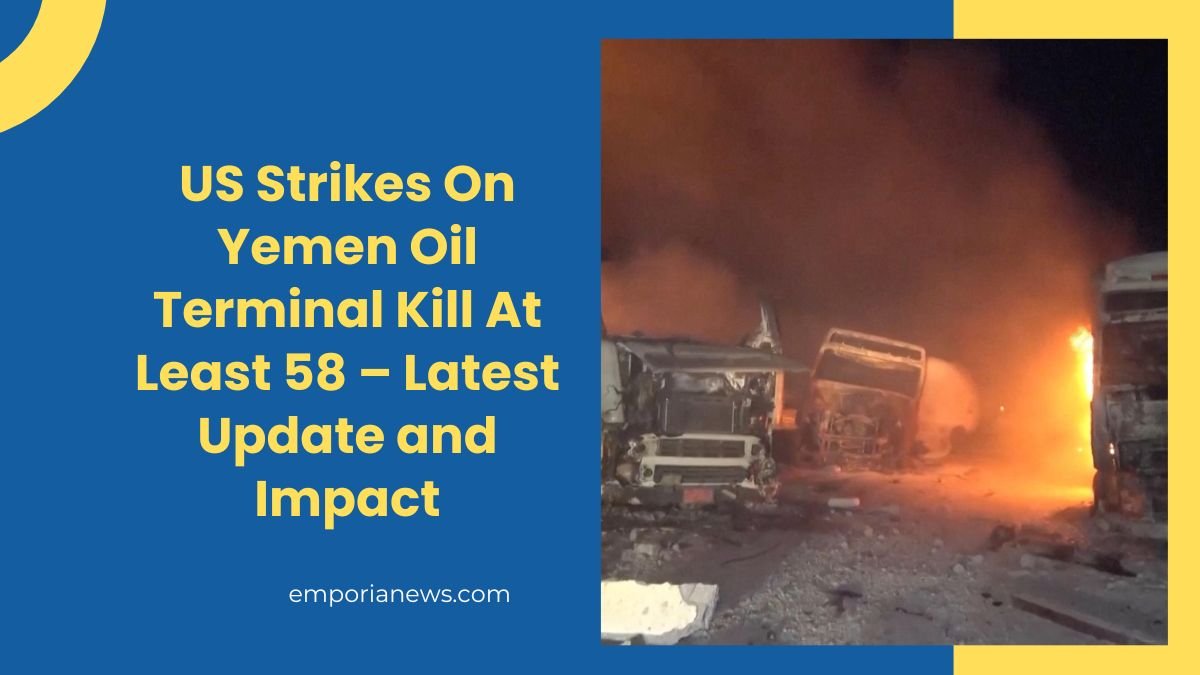In a significant escalation of tensions in the Middle East, US airstrikes have reportedly targeted a key oil terminal in Yemen, resulting in at least 58 deaths.
The Houthis, a Yemeni militant group, have blamed the strikes for the casualties, although US officials have not yet confirmed the figures. These airstrikes have raised concerns over the ongoing conflict in the region, the impact on Yemen’s economy, and broader geopolitical implications.
This article provides a detailed breakdown of the airstrike incident, the Houthis’ response, and the potential long-term consequences for Yemen, the Middle East, and international relations.
Overview of the Incident
On April 2025, the US launched airstrikes on an oil terminal located in the Marib province, which is under Houthi control. According to the Houthis, the attack killed at least 58 people, including several workers at the facility.
The oil terminal, which handles a significant portion of Yemen’s oil exports, has been a strategic target throughout the ongoing conflict between the Houthis and the Yemeni government, backed by a Saudi-led coalition.
| Event | Details |
|---|---|
| Date | April 2025 |
| Target | Oil Terminal in Marib province, Yemen |
| Casualties | At least 58 people killed |
| Responsible Party | US Airstrikes |
| Houthi Response | Claims responsibility for the majority of casualties |
| Strategic Impact | Potential disruption to oil exports and further regional destabilization |
The Houthis’ Perspective on the Strikes
The Houthis have strongly condemned the US airstrikes, describing them as an escalation of violence in an already volatile region.
The group, which controls large parts of Yemen, particularly in the north, has accused the US of exacerbating the suffering of the Yemeni people, many of whom are already living in dire conditions due to the ongoing civil war.
In a statement, the Houthi spokesperson vowed to take “strong retaliatory action” against US interests and assets in the region. This could further escalate the conflict, which has already resulted in tens of thousands of deaths and a severe humanitarian crisis.
Geopolitical Impact of the Airstrikes
The US involvement in Yemen has long been a controversial issue. The US has supported the Yemeni government in its fight against the Houthi rebels, who are backed by Iran. These airstrikes mark an increase in direct military action against Houthi targets, raising concerns over the wider regional impact.
- Impact on Yemen’s Economy: The oil terminal in Marib is a critical asset for Yemen’s oil exports, which make up a significant portion of the country’s economic activity. These airstrikes could lead to disruption in oil supplies, further deepening Yemen’s economic woes.
- Impact on International Relations: The attacks are expected to strain the already fragile relations between the US and Iran, as the Houthis are supported by Tehran. Tensions could escalate further, especially with the ongoing Iran-US standoff in the region.
- Humanitarian Concerns: Yemen is already grappling with one of the worst humanitarian crises in the world. Thousands of civilians have died in the war, and millions are displaced. These airstrikes could worsen the situation, leading to more displacement and casualties.
US Response to the Strikes
While the US has not officially confirmed the exact number of casualties, it has defended the airstrikes, stating that the operation was aimed at countering Houthi military threats and safeguarding regional stability.
The Pentagon issued a statement emphasizing the strategic importance of defending international shipping lanes and ensuring the security of Yemen’s oil assets.
However, this justification has not been sufficient for many critics, who argue that these strikes could escalate the conflict further, hurting civilians and deepening the humanitarian crisis.
How the Situation Could Evolve
The situation in Yemen remains fluid, and the consequences of the US strikes are still unfolding. The Houthis have vowed retaliation, and tensions could rise sharply in the coming weeks.
This could lead to further military operations in the region, including potential strikes on US interests, and intensify the already complicated dynamics between the US, Iran, and other Middle Eastern nations.
- Further Airstrikes: The US might conduct additional strikes against Houthi targets, potentially destabilizing the region further.
- International Involvement: Countries such as Saudi Arabia, Iran, and other regional powers might become more involved in the conflict, either through military support or diplomatic channels.
- Diplomatic Efforts: The UN and other international organizations may push for ceasefire talks and humanitarian aid initiatives.
The US airstrikes on Yemen’s oil terminal have significantly heightened tensions in an already volatile region. The Houthis have retaliated with strong rhetoric, and the situation remains tense.
As the conflict escalates, it is important to monitor the situation closely for any changes in military actions and diplomatic efforts.
The US, Yemen, and Iran will likely play pivotal roles in the coming months as the region braces for potential further escalations.




